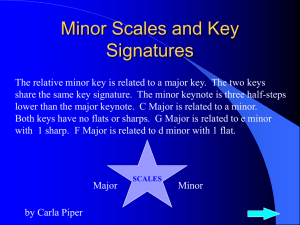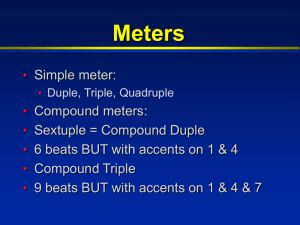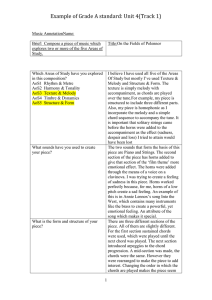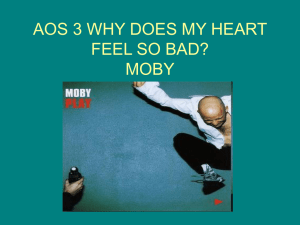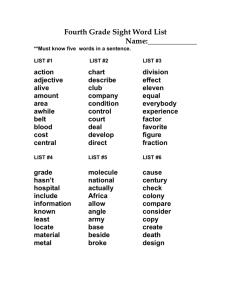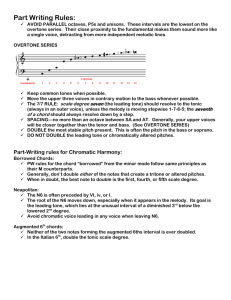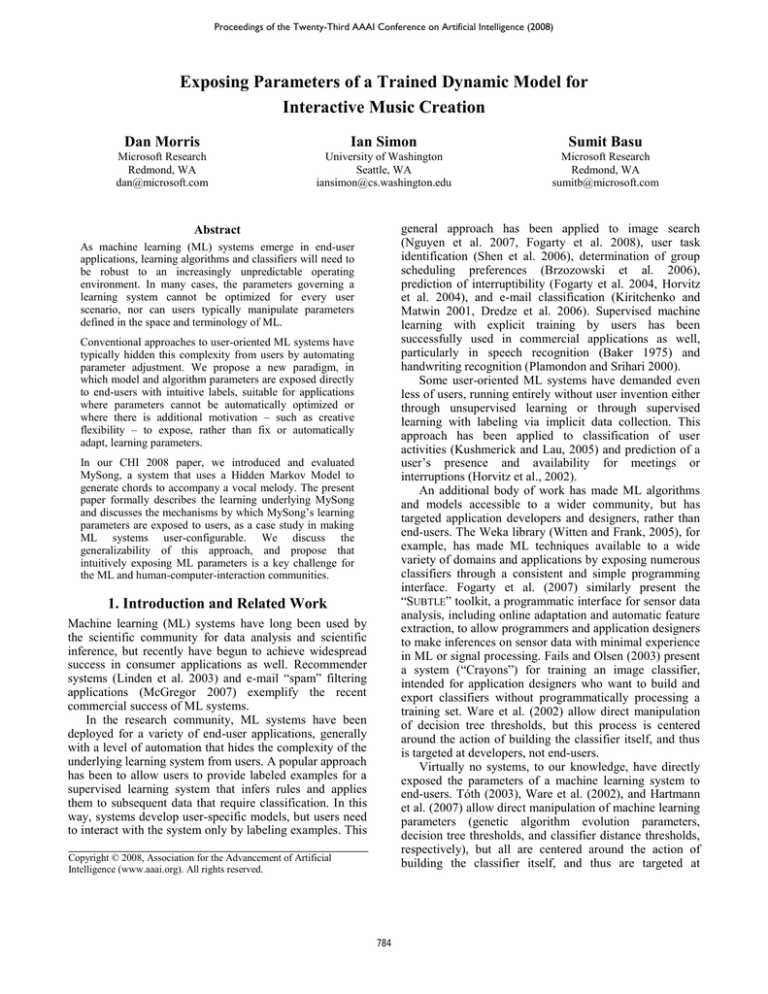
Proceedings of the Twenty-Third AAAI Conference on Artificial Intelligence (2008)
Exposing Parameters of a Trained Dynamic Model for
Interactive Music Creation
Dan Morris
Ian Simon
Sumit Basu
Microsoft Research
Redmond, WA
dan@microsoft.com
University of Washington
Seattle, WA
iansimon@cs.washington.edu
Microsoft Research
Redmond, WA
sumitb@microsoft.com
general approach has been applied to image search
(Nguyen et al. 2007, Fogarty et al. 2008), user task
identification (Shen et al. 2006), determination of group
scheduling preferences (Brzozowski et al. 2006),
prediction of interruptibility (Fogarty et al. 2004, Horvitz
et al. 2004), and e-mail classification (Kiritchenko and
Matwin 2001, Dredze et al. 2006). Supervised machine
learning with explicit training by users has been
successfully used in commercial applications as well,
particularly in speech recognition (Baker 1975) and
handwriting recognition (Plamondon and Srihari 2000).
Some user-oriented ML systems have demanded even
less of users, running entirely without user invention either
through unsupervised learning or through supervised
learning with labeling via implicit data collection. This
approach has been applied to classification of user
activities (Kushmerick and Lau, 2005) and prediction of a
user‟s presence and availability for meetings or
interruptions (Horvitz et al., 2002).
An additional body of work has made ML algorithms
and models accessible to a wider community, but has
targeted application developers and designers, rather than
end-users. The Weka library (Witten and Frank, 2005), for
example, has made ML techniques available to a wide
variety of domains and applications by exposing numerous
classifiers through a consistent and simple programming
interface. Fogarty et al. (2007) similarly present the
“SUBTLE” toolkit, a programmatic interface for sensor data
analysis, including online adaptation and automatic feature
extraction, to allow programmers and application designers
to make inferences on sensor data with minimal experience
in ML or signal processing. Fails and Olsen (2003) present
a system (“Crayons”) for training an image classifier,
intended for application designers who want to build and
export classifiers without programmatically processing a
training set. Ware et al. (2002) allow direct manipulation
of decision tree thresholds, but this process is centered
around the action of building the classifier itself, and thus
is targeted at developers, not end-users.
Virtually no systems, to our knowledge, have directly
exposed the parameters of a machine learning system to
end-users. Tóth (2003), Ware et al. (2002), and Hartmann
et al. (2007) allow direct manipulation of machine learning
parameters (genetic algorithm evolution parameters,
decision tree thresholds, and classifier distance thresholds,
respectively), but all are centered around the action of
building the classifier itself, and thus are targeted at
Abstract
As machine learning (ML) systems emerge in end-user
applications, learning algorithms and classifiers will need to
be robust to an increasingly unpredictable operating
environment. In many cases, the parameters governing a
learning system cannot be optimized for every user
scenario, nor can users typically manipulate parameters
defined in the space and terminology of ML.
Conventional approaches to user-oriented ML systems have
typically hidden this complexity from users by automating
parameter adjustment. We propose a new paradigm, in
which model and algorithm parameters are exposed directly
to end-users with intuitive labels, suitable for applications
where parameters cannot be automatically optimized or
where there is additional motivation – such as creative
flexibility – to expose, rather than fix or automatically
adapt, learning parameters.
In our CHI 2008 paper, we introduced and evaluated
MySong, a system that uses a Hidden Markov Model to
generate chords to accompany a vocal melody. The present
paper formally describes the learning underlying MySong
and discusses the mechanisms by which MySong‟s learning
parameters are exposed to users, as a case study in making
ML systems user-configurable. We discuss the
generalizability of this approach, and propose that
intuitively exposing ML parameters is a key challenge for
the ML and human-computer-interaction communities.
1. Introduction and Related Work
Machine learning (ML) systems have long been used by
the scientific community for data analysis and scientific
inference, but recently have begun to achieve widespread
success in consumer applications as well. Recommender
systems (Linden et al. 2003) and e-mail “spam” filtering
applications (McGregor 2007) exemplify the recent
commercial success of ML systems.
In the research community, ML systems have been
deployed for a variety of end-user applications, generally
with a level of automation that hides the complexity of the
underlying learning system from users. A popular approach
has been to allow users to provide labeled examples for a
supervised learning system that infers rules and applies
them to subsequent data that require classification. In this
way, systems develop user-specific models, but users need
to interact with the system only by labeling examples. This
Copyright © 2008, Association for the Advancement of Artificial
Intelligence (www.aaai.org). All rights reserved.
784
application designers, not end-users.
The primary reason that end-users have traditionally
been shielded from ML parameter adjustment or model
details is that few users have the expertise or even the
vocabulary required to meaningfully interact with a system
at this level. However, recent field study results (Tullio et
al. 2007, Stumpf et al. 2007) suggest that users can in fact
build meaningful mental models of machine learning
systems, suggesting that exposing more details of such
systems may be a promising approach.
We postulate several reasons why, despite the barriers
in intuitive interface development, exposing ML concepts
to end-users will benefit certain scenarios:
systems to end-users.
We conclude this section with a brief description of other
work in the computer music domain that ties intuitive
labels or parameters to machine learning systems. For a
more comprehensive overview of work specifically related
to the MySong system, see (Simon et al. 2008).
Legaspi et al. (2007) used explicit labels to learn a
model mapping musical features to affect and emotion, for
the purpose of generating new music that inspires a userspecific emotional response. Given training data and a
desired affective descriptive, this system builds a firstorder logic that generates song components and uses a
genetic algorithm to build chords from fundamental
musical units. Turnbull et al. (2008) and Torres et al.
(2007) solve the related problem of conducting a search
based on intuitive labels; this system learns a Gaussian
mixture model that maps local audio features to intuitive
labels using an explicitly-labeled data set, and allows users
to search a music database using intuitive labels.
To our knowledge, no previous systems exist that allow
users to directly manipulate components or parameters of a
learning system for a creativity-support application.
1) As ML systems are increasingly deployed “in the wild”,
it will become increasingly difficult to select
parameters that apply to all environments. End-user
adjustment allows tailoring to a specific scenario.
2) Allowing direct manipulation of an underlying model
promotes user exploration and exploratory usage of
applications that would be stifled with fixed parameters
or automatic parameter adjustment.
3) This approach will also lend itself directly to the
application-designer scenarios discussed above, where
a user with some expertise in machine learning or
willingness to perform deeper interactions is building
or editing a learning model that will be exported and
applied to an end-user system.
2. System Description
2.1 MySong Overview
The MySong system allows a user with no knowledge of
chords or music theory to quickly create and explore
chord-based accompaniments for a vocal melody. Primary
goals of the system are to enable non-musically-trained
users to participate in the craft of songwriting and to
provide songwriters and musicians with an interactive,
exploratory scratchpad for songs.
The basic interaction paradigm requires a user to
simply click on a “record” button, sing a melody while
listening to a drum pattern that fixes the timing of musical
beats, and click on a “stop” button to end the recording.
MySong then immediately generates a set of chords to
accompany the recorded vocal melody and uses a
commercial system to render those chords as an audio
accompaniment in a user-selected style. The core of this
system is a Hidden Markov Model that represents a chord
sequence and is used to generate chords to accompany a
vocal melody; in this section we will describe the
architecture and training of that model. In Section 3, we
will discuss several mechanisms by which users can
intuitively interact with that model after recording a
melody.
4) In certain scenarios, such as the one presented in this
paper, there is intrinsic value to providing more degrees
of freedom in a user‟s interaction with a model. In this
case, these additional degrees of freedom lead directly
to increased creative expressiveness.
In our CHI 2008 paper (Simon et al. 2008), we introduced
MySong, a system that uses a Hidden Markov Model to
automatically generate chords to accompany a vocal
melody. We have demonstrated that this is a powerful tool
for allowing non-musicians to create accompanied music.
However, allowing the user to explore the space of
possible accompaniments – without requiring knowledge
of either music theory or machine learning – further
enhances the creative expression available with this tool
and renders it useful for novices and songwriters alike.
In this paper, we make the following three contributions:
1) We formally describe MySong‟s algorithm for
automatically generating accompaniments.
2.2 Model and Assumptions
2) We discuss the novel mechanisms by which MySong‟s
machine learning parameters are exposed to users, as a
case study in the increasingly-important space of
making AI and ML systems user-configurable.
We model a vocal melody as a sequence of notes in which
each element corresponds to a specific “pitch class”: a
frequency corresponding to one of the standard 12 tones in
the chromatic musical scale (e.g. C, C#, D, etc.). In our
training phase, this sequence will be derived from
published musical scores (Section 2.3). In our decoding
phase, this sequence is derived by sampling and
discretizing a user‟s vocal melody (Section 2.4).
3) We discuss the generalization of this approach to other
domains, and we conclude by calling on the ML and
HCI communities to develop additional intuitive
mechanisms for exposing details of machine learning
785
For a given chord type c, we refer to the vector of (a
priori) expected pitch class frequencies (i.e., as estimated
from training data) for a measure containing that chord as
µc, and the element of µc corresponding to a specific pitch
class p as 𝜇𝑐𝑝 .
We thus model the probability of the pitch histogram x
occurring in a measure with a chord c as:
In popular musical genres, a musical accompaniment is
typically represented for performance purposes as a
sequence of chords (often referred to as a “lead sheet”). We
thus build our model around this representation, and
assume that this is adequate for producing appropriate
accompaniments. This assumption is appropriate for a wide
variety of popular musical genres (rock, pop, country,
R&B, jazz, etc.), but would not be valid for non-chordbased music, including a significant fraction of classical
pieces, heavy metal pieces, etc.
We make the following additional assumptions:
𝑃 𝑥𝑐 =
𝑇
𝑖=1
𝑃 𝑛𝑖 𝜇 𝑐
Here 𝑛𝑖 is the note appearing in timeslice 𝑖 and T is the
number of timeslices in a measure. Looking at this in the
log space, noticing that the probability of seeing note 𝑛 at
some timeslice given our model is precisely 𝜇𝑛 , and then
letting 𝑇 go to infinity (infinitely short timeslices), we
have:
log 𝑃 𝑥 𝑐 =
1) Each chord in a sequence lasts for exactly one
measure. Here we use the term “measure” to refer to
the smallest amount of time for which a chord will be
played; in general this corresponds to a typical musical
measure, but this is not necessary; hence this
assumption can be made without loss of generality.
𝑇
2) All notes can be reduced to a single octave without
losing information that is meaningful to chord
selection; therefore, there are only 12 possible pitch
classes.
𝑖=1
log 𝜇𝑐𝑖 ∝
12
𝑘 =1
𝑡𝑘 log 𝜇𝑐𝑘 ∝
12
𝑘=1
𝑥𝑘 log 𝑢𝑐𝑘
Here 𝑘 is a pitch class and 𝑡𝑘 is the amount of time spent in
the pitch class k. In short, we can compute the relative
probability of an observation vector x for a chord c by
taking the dot-product of that observation vector with the
log of the vector of expected pitch class frequencies 𝑢𝑐𝑘 .
3) A sufficient statistic (for the purpose of chordal
accompaniment) for the notes in a measure is the
fraction of the measure during which each pitch class
(C, C#, D, etc.) is heard.
2.2.2 Chord transitions
A simple extension to the notes-only model is to also
model the likelihood of transitions among chords, i.e. to
incorporate the fact that for a chord ct in a chord sequence
(chord type c occurring at measure t), the distribution of
probabilities over possible subsequent chords ct+1 is highly
non-uniform. In other words, in popular music, certain
chord transitions are much more likely than others, an
important basic principle in music theory.
We represent the probability of a chord ct+1 occurring
in the measure following chord ct as P(ct+1 | ct). These
probabilities can be stored in an m-by-m table, where m is
the total number of chords in our dictionary.
4) The musical key (the prior distribution of chords and
melody notes) does not change within a melody.
5) Possible chords are chosen from a finite dictionary
available during model training.
6) The location of measure boundaries in a vocal melody
is known during both training and interactive use of
our model. In the training phase, measure boundaries
are delineated in training data; during interactive use,
measure boundaries are determined by the timing of
the drum beat along with which the user sings (Section
2.1).
2.2.3 Hidden Markov Model
MySong uses as its core representation a Hidden Markov
Model in which each measure corresponds to a single node
whose (initially unknown) state represents the chord
selected to be played during that measure. The observation
at each node is the melody fragment sung during that
measure, treated as in Section 2.2.1. Transition
probabilities among states are estimated from training data
(Section 2.3) and are stored as in Section 2.2.2.
2.2.1 Notes-only model
Given these assumptions, one simple model is to choose
the chord for each measure considering only the notes that
appear in that measure. So, for each measure, the chord is
chosen to maximize P(notes | chord). We will begin our
discussion with this simple model, and build our Hidden
Markov Model on this description.
We sample the sequence of notes observed in a
measure of melody at regular intervals (these intervals are
arbitrarily short and do not correspond to musical note
durations), and our model‟s observations are the notes
occurring at each interval i. Because we assume that the
precise temporal ordering of notes is not relevant to the
selection of a chord within a measure (assumption (3)
above), this sampling is equivalent to building a “pitch
histogram”: a 12-dimensional vector x in which each
element corresponds to the amount of time spent in the
corresponding pitch class.
2.3 Training
We train the Hidden Markov Model described in Section
2.2.3 using a database of 300 “lead sheets”: published
musical scores containing melodies along with chord
sequences aligned to those melodies. Without loss of
generality, all of these lead sheets are transposed to a
single musical key before training (this will not limit us to
working with melodies in this key; we discuss our handling
786
p corresponding to fmax as 𝑝 = 12 log 2 𝑓𝑚𝑎𝑥 𝑓𝑐 ,
where fc is the frequency of a member of a known
musical pitch class (we choose the note C5=523.2Hz).
10) For all windows w in the measure m, compute the
offset between p and the nearest known musical pitch
class, and compute the mean poffset of all such offsets.
11) Add poffset to the value p for each window; this shifts
the computed pitch sequence to optimally align with
the standard chromatic scale (i.e., this minimizes the
mean-squared difference between the computed
frequencies and standard musical notes subject to the
constraint that relative pitches must be preserved).
12) Round each value p to the nearest integer pint and
compute the final pitch class as pint mod 12; the
histogram of these integer pitch classes over the entire
measure m is the observation vector x for this measure.
of arbitrary-key melodies in Section 2.6).
Transition probabilities (Section 2.2.2) are computed
by counting the chord transitions occurring from each
chord type to each chord type in the database and
normalizing these counts. “Beginning of song” and “end of
song” are included in the transition matrix, but will not be
part of the dictionary from which node states are assigned.
2.4 Pitch-tracking
In order to provide the observation vector x at each
measure, a pitch-tracking step analyzes each measure of
vocal audio, computes the fundamental frequency over
40ms windows at 10ms intervals, discretizes those
frequencies into 12 pitch classes, and builds the vector x as
a histogram of samples observed in each pitch class.
We note that this is not equivalent to the problem of
transcribing a musical melody from a singer‟s voice;
because our model assumes that a pitch histogram is a
sufficient description of a measure for purposes of
harmonization, we do not build a detailed rhythmic
transcription of the melody. This approach allows MySong
to be robust to small errors in both a user‟s pitch accuracy
and our own frequency estimation.
We compute the fundamental frequency using a variant
on the method of (Boersma, 1993), but – as we assume that
octave information is not relevant to harmonization – we
do not perform the dynamic programming step described in
that work, which primarily serves to eliminate octave
errors. We briefly summarize our pitch-tracking procedure
here; constants are selected empirically and have been
robust to a wide range of vocal audio:
2.5 Decoding
Given the vector x output by the pitch-tracking system for
each measure in a recorded melody, MySong chooses the
sequence of chords that maximizes the likelihood of this
sequence of vectors. I.e., our harmonization model selects
chords that maximize the following objective function over
the sequence chords for the sequence of observation
vectors melody:
𝐿 = log 𝑃 𝑐ℎ𝑜𝑟𝑑𝑠 + log 𝑃 𝑚𝑒𝑙𝑜𝑑𝑦|𝑐ℎ𝑜𝑟𝑑𝑠
…where:
log 𝑃 𝑐ℎ𝑜𝑟𝑑𝑠 =
𝑛
log 𝑃 𝑐1 |𝑠𝑡𝑎𝑟𝑡 +
1) Extract a single measure m of audio data, sampled at
22kHz and normalized to the range (-1.0, 1.0).
2) Extract 40ms windows w of audio data at 10ms
intervals (100Hz), and center each window w around
zero-amplitude by subtracting its mean.
3) Discard any window w whose root-mean-squared
(RMS) amplitude is less than 0.01 or whose RMS
amplitude is less than 0.05 times the RMS amplitude
of the measure; these heuristics indicate near-silence.
4) Compute the power spectrum (the magnitude of the
zero-padded FFT) of the window w, then compute the
autocorrelation a of the window w by taking the IFFT
of its power spectrum.
5) Normalize the autocorrelation a by the mean-squared
amplitude (energy) of the window w.
6) Within the range of a corresponding to the frequency
range [75Hz, 300Hz] find the minimum and maximum
normalized autocorrelation values amin and amax.
7) Discard any window w for which amax < 0.4 or amin >
0.05 . These heuristics indicate weak autocorrelation
peaks and, consequently, non-pitched voice.
8) For each qualifying window w, compute the frequency
fmax corresponding to the peak amax. This corresponds
to the estimated fundamental frequency at w.
9) Compute the continuous (non-discretized) pitch class
…and:
log 𝑃 𝑐𝑖 |𝑐𝑖−1 + log 𝑃 𝑒𝑛𝑑|𝑐𝑛
𝑖=2
𝑛
log 𝑃 𝑚𝑒𝑙𝑜𝑑𝑦|𝑐ℎ𝑜𝑟𝑑𝑠 =
log 𝑃 𝑥𝑖 |𝑐𝑖
𝑖=1
Here n is the total number of recorded measures (known a
priori since the user sang along with a drum beat that
defined measure timing), ck is the chord assigned to
measure k, 𝑃(𝑐1 |𝑠𝑡𝑎𝑟𝑡) is the (known) probability that a
song begins with c1, 𝑃(𝑒𝑛𝑑|𝑐𝑛 ) is the probability that a
(known) probability that a song ends with cn, and xk is the
observation vector corresponding to measure k.
We use a single parameter 0 ≤ 𝛼 ≤ 1 to weight the
importance of observations versus transitions (the
interpretation of this parameter is discussed in more detail
in Section 3.2). The objective function then becomes:
𝐿 = 1 − 𝛼 log 𝑃 𝑐ℎ𝑜𝑟𝑑𝑠 + 𝛼 log 𝑃 𝑚𝑒𝑙𝑜𝑑𝑦|𝑐ℎ𝑜𝑟𝑑𝑠
For the Hidden Markov Model defined in Section 2.2.3, the
Viterbi algorithm chooses the sequence of chords 𝑐1 … 𝑐𝑛
that maximizes this total likelihood. This is the set of
chords we present to the user for a new melody.
2.6 Key determination
As we discuss above, we transpose all the songs in our
training database into a single musical key (expected
787
components of the underlying learning system via
interactions that are intuitive to users. Each of these
mechanisms will modify our objective function in some
way; we note that the computational efficiency of the
Viterbi procedure allows all of these mechanisms to be
manipulated in real-time.
distribution of notes and chords) before training our model.
It is musically reasonable to assume that the transition
matrices in each key are identical other than a simple
circular shift of the transition matrix, so we maximize the
effectiveness of our training database by considering all 12
keys to be equivalent for the purposes of harmonization.
However, when harmonizing a new melody, we do not
know the key in which the user sang. We therefore
consider multiple transpositions Tk applied to the vocal
melody and all candidate chord sequences, where 0 ≤ 𝑘 <
12. Tk(chords) transposes each chord by k half-steps, and
Tk(melody) transposes the new melody (the observation
vectors x) by k half-steps. The objective function then
becomes:
3.1 The “Happy Factor”
In practice, a single transition matrix is insufficient to
capture the variation among chord progressions.
Orthogonal to the classification of songs into musical keys,
songs can typically be assigned to a “mode”, which
indicates a particular distribution of chords within the
distribution of notes representing the key, and an
associated emotional character. The two most common
modes in popular music are the “major” and “minor”
modes. We therefore divide our training database into
major- and minor-mode songs before performing the
training procedure described in Section 2.3 and compute
separate transition probabilities, henceforth called Pmaj and
Pmin, for each sub-database.
We perform this modal division of our training
database automatically, using an iterative procedure. To
begin, we initialize the transition matrices Pmaj and Pmin
using a series of simple heuristics (Appendix A).
After initialization, we alternate between the following
two steps in a k-means-like manner until the sets of songs
classified as major and minor do not change:
𝐿 = log 𝑃 𝑇𝑘 𝑐ℎ𝑜𝑟𝑑𝑠
+ log 𝑃 𝑇𝑘 𝑚𝑒𝑙𝑜𝑑𝑦 |𝑇𝑘 𝑐ℎ𝑜𝑟𝑑𝑠
We now optimize over chords and k by computing the
optimal chord sequence for each k, and then choosing the
key k (and corresponding sequence) with the highest
likelihood. Empirically, this method nearly always selects
the same key that a musician would manually assign to a
new melody. For example, for the 26 melodies used in a
recent evaluation of our system (Simon et al. 2008), this
approach selected the correct key for all 26 melodies.
3. Exposing Learning Parameters
Using the model we presented in Section 2, a user could
record a vocal melody and have a mathematically-optimal
sequence of chords assigned to that melody. In many cases
this would provide satisfactory results, but we would like
the user to be able to subsequently manipulate the selected
sequence of chords for two reasons:
1) For each song in the database, estimate its likelihood
using both the major and minor transition models, and
assign the song to whichever yields higher likelihood.
Likelihood is computed as in Section 2.5.
1) A major goal of our system is to provide a creativity
support tool; if users cannot modify the output of our
core algorithm, we are not enabling a creative process.
2) The mathematically-optimal sequence of chords for any
model may not always be the subjectively-optimal
sequence of chords, and subjective preference may vary
among users. Therefore it is important to allow a user to
modify the selected chord sequence, treating our
automatically-selected chords as a starting point.
When this procedure is complete, we have two transition
matrices Pmaj and Pmin available during the decoding stage.
We use a parameter 0 ≤ 𝛽 ≤ 1 (called the happy factor) to
weight the relative contribution of these two transition
models. The transition probabilities used in our objective
function now look like:
2) Re-compute the major and minor transition matrices
separately using the set of songs assigned to each
model, by counting all transitions and normalizing.
log 𝑃 𝑐𝑖 |𝑐𝑖−1
= 𝛽 log 𝑃maj 𝑐𝑖 |𝑐𝑖−1 + 1 − 𝛽 log 𝑃min 𝑐𝑖 |𝑐𝑖−1
However, our target audience is unfamiliar with musical
notation, so asking them to directly manipulate the chord
sequence would undermine a major goal of our system.
Furthermore, even a musically-trained user derives the
most benefit from this system when leveraging the
underlying optimization framework to rapidly explore
chord patterns. Therefore we would like the manipulation
stage that takes place after the original optimization to also
be enhanced by the underlying learning mechanisms.
However, our target audience is also unfamiliar with
concepts and notation from machine learning, and could
not reasonably be asked to manipulate “observation
weights”, “transition matrices”, etc. Therefore we now turn
our attention to the mechanisms by which MySong exposes
The reader will likely find this form of mixing unusual, as
we are linearly mixing transition matrices in the log
domain. In the non-log domain, mixing two transition
matrices with 𝛽 and 1 − 𝛽 yields a valid transition matrix:
𝑃 𝑐𝑖 |𝑐𝑖−1 = 𝛽𝑃𝑚𝑎𝑗 𝑐𝑖 |𝑐𝑖−1 + 1 − 𝛽 𝑃𝑚𝑖𝑛 𝑐𝑖 |𝑐𝑖−1
However, in the log domain, we are effectively taking the
product of the two transition matrices raised to
complementary powers, which will not (without
normalization) result in a valid transition matrix:
788
Setting 𝛼 = 1 causes MySong to ignore the transition
matrices entirely, leading to surprising and unfamiliar
chord progressions that optimally match the recorded
melody. Setting 𝛼 = 0 causes MySong to ignore the
observed melody entirely, leading to familiar chord
progressions; even this extreme setting can be useful, for
example, when building an accompaniment for nonpitched vocals (such as rap) or experimenting with
instrumental chord patterns.
We expose this observation-weighting factor as another
slider on MySong‟s graphical user interface, labeled as the
“Jazz Factor”. We do not claim that this in any way
represents a bias toward accompaniments in the jazz genre,
but pilot testing suggested that this was a fairly intuitive
name for this parameter.
We highlight that even though the precise behavior of
this slider is difficult to explain without introducing
machine learning terminology, novice users were able to
effectively use this slider to explore a wide space of
accompaniments, all of which were musically reasonable
(as they each optimized our objective function for a
particular value of α). This underscores another key point
of this work: for certain applications, providing reasonably
intuitive handles to algorithmic parameters, with
appropriate constraints that prevent non-intuitive behavior,
can allow users to explore a parameter space and therefore
make effective use of the underlying system while
introducing human knowledge and subjective preference.
𝑃 𝑐𝑖 |𝑐𝑖−1 =
𝑃𝑚𝑎𝑗 𝑐𝑖 |𝑐𝑖−1
𝛽
∙ 𝑃𝑚𝑖𝑛 𝑐𝑖 |𝑐𝑖−1
1−𝛽
Empirically, this method produced chord combinations that
were perceived to be better than those achieved via linear
mixing; the reasons behind this are subtle. Since the two
matrices are sufficiently different from each other (i.e.,
very major and very minor), the weighted average of the
two results in a musically non-sensical middle ground. To
see why this happens, imagine that in the major-key
transition matrix the C chord always transitions to a G
chord, whereas in the minor-key transition matrix the C
chord always transitions to an A-minor chord. Linearly
mixing these results in the transition probability being split
between G and A-minor according to 𝛽. For medium
values of 𝛽, both are almost equally likely, which in
practice is not the case in songs that mix major and minor
components.
In fact, while many songs have both major- and minormode components, major-mode songs tend to express this
combination by reinforcing the minor-mode components
that are already typical to major-mode songs (and vice
versa), as opposed to mixing in all possible minor
transitions/chords. This is precisely what our log-space
mixing does: when transition matrices are multiplied,
common components are reinforced, while disparate
components are reduced in probability.
We highlight this point as an example of a nontraditional engineering/learning decision, guided by
usability and musicality, at the expense of “correctness” of
the underlying system. We argue that such tradeoffs of
usability and intuitiveness for “correctness” may be
increasingly appropriate in user-centric ML systems.
The value 𝛽 is directly exposed to the user as a slider
on MySong‟s graphical user interface, and is labeled as the
“Happy Factor”. Users do not need to understand the actual
implementation of this factor as a transition-matrix
blending weight, nor do non-musically-trained users need
to understand the nature of major and minor modes to
effectively use this slider. In the usability study we present
in (Simon et al. 2008), non-musically-trained users were
able to create subjectively-appropriate accompaniments for
melodies. During this study, all 13 participants made
extensive and successful use of this slider.
We also note that at values of 0 and 1 for 𝛽, we are
selecting the learned transition matrices pmin or pmaj,.
3.3 “Top Chords” List
When working with a chord progression or
accompaniment, musicians often experiment with
replacing individual chords with other chords that are
expected to be appropriate at that point in the song and
comparing the subjective impact of each. The model
underlying MySong allows us to provide this same
experimentation process to non-musically-trained users
who would have no intuitive metric for possiblyappropriate chord substitutions.
In MySong‟s graphical user interface, right-clicking on
a chord brings up a list of the top five chords that MySong
“recommends” for this measure. For the ith measure, we
compute this listed by sorting all possible chords according
to the following quantity:
𝐿𝑖 = 𝛼log 𝑃 𝑥𝑖 |𝑐𝑖 + 1 − 𝛼 log 𝑃 𝑐𝑖 |𝑐𝑖−1
+ 1 − 𝛼 log 𝑃 𝑐𝑖+1 |𝑐𝑖
3.2 The “Jazz Factor”
These are simply the terms in the global objective function
which are dependent on the chord in the ith measure. This
metric takes into account both melody and chord context,
but again does not require a user to understand the
underlying model.
The objective function presented in Section 2.5 summed
the likelihood of observations and transitions, implicitly
assuming that these contribute equally to the subjective
quality of a chord sequence. In practice, this is not always
the case.
We use a single parameter 0 ≤ 𝛼 ≤ 1, called the jazz
factor, to weight the importance of observations versus
transitions. The objective function then becomes:
3.4 Chord-locking
Often a user encounters a chord that is subjectively
pleasing when paired with the melody at a particular
measure. The user might like to continue varying other
parameters (e.g. α and β) while maintaining this chord, and
𝐿 = 1 − 𝛼 log 𝑃 𝑐ℎ𝑜𝑟𝑑𝑠 + 𝛼 log 𝑃 𝑚𝑒𝑙𝑜𝑑𝑦|𝑐ℎ𝑜𝑟𝑑𝑠
789
guaranteeing that transitions in and out of this measure will
still follow the appropriate “rules” defined by the trained
transition model.
MySong thus allows a user to “lock” a particular chord
via the graphical user interface. When a chord is “locked”,
further manipulation of α and β won‟t change this chord,
but – importantly – the selection of adjacent chords will
reflect the locked chord. Locking the chord at the ith
measure to chord C has the following effect on our
objective function:
1 if 𝑐𝑖 = 𝐶
𝑃 𝑐𝑖 |𝑐𝑖−1 =
0 if 𝑐𝑖 ≠ 𝐶
“Easy to understand concepts (happy, jazzy)” (P9)
“Sliders are easy.” (P10)
“[Sliders are] easy, not complicated. No need to
think.” (P11)
5. Discussion: Interactive Decoding
3.5 Ignore melody
We have presented MySong as a case study in “interactive
decoding”: bringing the user into the ML-driven decoding
process by exposing system parameters in intuitive terms.
We highlight again that this differs from previous work in
user systems, which typically minimize the degree to
which learning parameters are exposed to users, and from
previous work in ML toolkits, which typically expose a
large set of parameters to developers and engineers.
We propose that this new “middle ground” could have
similar success in a number of other areas. A number of
creativity-oriented systems, for example, could provide
similar assistance to untrained users while providing
sufficient degrees of freedom to allow a deep creative
process. This approach could be applied not just to musical
accompaniment, but
to painting,
computational
photography, painting, graphic design, writing, etc.
Outside of the creativity space, any system that uses
machine learning to process complex data could also
benefit from this approach to allow the user some level of
interactivity. Image- and video-editing applications, for
example, increasingly provide facilities for face detection
and processing, keyframe and thumbnail selection, object
removal, automatic cropping, etc. In almost all of these
cases, the underlying system has a series of parameters that
may typically be hidden from users to minimize
complexity, but in all of these cases, as with MySong,
users‟ overall productivity may in fact benefit from an
ability to rapidly explore the space of relevant parameters.
We do not argue that all end-user systems that
incorporate some form of machine learning should expose
core parameters to users; inevitably, this process does add
interface complexity and the potential for users to develop
an inaccurate intuition for how a system behaves. We
propose that this approach will successful in spaces where
target users have sufficient motivation to explore a
parameter space and build an intuition for how parameters
behave. Creativity support is an excellent example of such
a space, where users derive a direct benefit in
expressiveness by exploring the parameter space and
building a mental model of a system. Scientific data
visualization is another domain in which users have a
vested interest in exploring a large space, so we expect a
similar benefit if this approach is applied to classification
or regression systems for scientific data.
We further propose that for systems that benefit from
For several reasons, it is sometimes useful to disregard the
vocal melody for a measure. For example, it may be the
case that a measure was performed inaccurately, that a
measure contains non-musical speech, or that pitchtracking errors yield an observation vector that does not
correlate well with the user‟s intended pitch. MySong thus
allows a user to ignore a particular measure of audio via
the graphical user interface.
Ignoring the vocal input for the ith measure can be
efficiently accomplished by simply ignoring this measure‟s
log 𝑃 𝑥𝑖 |𝑐𝑖 term, leaving it out of the global optimization.
In practice this is implemented by locally setting the
observation weight α to 0.
4. Results
For brevity, we will not repeat the results of the usability
studies that are the focus of (Simon et al. 2008). We
summarize our two studies as follows:
1) A listening study showed that MySong produces
subjectively-appropriate accompaniments. This is a
validation of the model and objective function
described in Section 2.
2) A usability study showed that MySong‟s interaction
techniques provided are intuitive to novice, nonmusically-trained users. This is a validation of the
interaction techniques described in Section 3, as well
as the overall paradigm of vocally-driven automatic
accompaniment.
As further verification of the intuitiveness of the
mechanisms by which we have exposed MySong‟s
learning parameters to users, we provide several quotes
from participants in our usability study that provide
qualitative support for the quantitative results of our
usability study. We consider qualitative, subjective
validation to be central to our core argument that, in certain
situations, it is appropriate to expose learning parameters
directly to an end-user.
When asked the free-response question “What things
were most helpful about this system?”, the following
responses were provided by study participants:
learning.” (P3)
“The ability to change the „mood‟ of the song just by
moving the slider.” (P5)
“The ranges that were available with the happy & jazz
factor.” (P8)
“The „happy/sad‟ and „jazzy‟ options are useful for
790
direct user interaction, it may be necessary not only to
make implementation decisions with “intuitiveness” in
mind (Section 3.1), but also to use the intuitiveness of the
parameter space as a metric for evaluating competing
learning approaches. The HMM used in MySong, for
example, comes with some limitations in terms of
generality relative to a more general or higher-order model,
but in terms of user experience, the ability to expose
relevant parameters in meaningful terms and the fact that
those parameters have predictable effects on the system
argue heavily in favor of the HMM as an appropriate
model for this system. This approach is in some ways in
contrast with more traditional approaches for selecting
learning systems, which focus on metrics such as
classification accuracy and computational performance.
2004.
Horvitz, E., Koch, P., Kadie, C., Jacobs, A. Coordinate:
Probabilistic Forecasting of Presence and Availability. Proc Conf
on Uncertainty and AI, 2002.
Kiritchenko, S. Matwin, S. Email classification with co-training.
Proc Conf Centre for Adv Stud on Collaborative Research, 2001.
Kushmerick, N. and Lau, T. Automated email activity
management: an unsupervised learning approach. IUI 2005.
Legaspi, R., Hashimoto, Y., Moriyama, K., Kurihara, S., Numao,
M. Music compositional intelligence with an affective flavor. IUI
2007.
Linden, G., Smith, B., York, J. Amazon.com Recommendations:
Item-to-Item Collaborative Filtering. IEEE Internet Computing 7,
1 (Jan. 2003), p76-80.
McGregor, C. Controlling spam with SpamAssassin. Linux J.
153, Jan 2007.
Nguyen, G., Worring, M., Smeulders, A. Interactive Search by
Direct Manipulation of Dissimilarity Space. IEEE Trans
Multimedia, 9(7), Nov 2007.
Plamondon, R and Srihari, S. On-Line and Off-Line Handwriting
Recognition: A Comprehensive Survey. IEEE Trans Pattern
Analysis & Mach Intelligence 22(1), 2000.
Shen, J., Li, L., Dietterich, T. G., Herlocker, J. L. A hybrid
learning system for recognizing user tasks from desktop activities
and email messages. IUI 2006.
Simon, I., Morris, D., and Basu, S. MySong: Automatic
Accompaniment Generation for Vocal Melodies. CHI 2008.
Stumpf, S., Rajaram, V., Li, L., Burnett, M., Dietterich, T.,
Sullivan, E., Drummond, R., Herlocker, J. Toward harnessing
user feedback for machine learning. IUI 2007.
Torres, D., Turnbull, D., Barrington, L., Lanckriet, G. Identifying
Words that are Musically Meaningful. Proc Intl Symp on Music
Information Retrieval (ISMIR), 2007.
Tóth, Z. A graphical user interface for evolutionary algorithms.
Acta Cybern. 16, 2 (Jan. 2003), 337-365.
Tullio, J., Dey, A. K., Chalecki, J., Fogarty, J. How it works: a
field study of non-technical users interacting with an intelligent
system. CHI 2007.
Turnbull, D., Barrington, L., Torres, D., Lanckriet, G. Semantic
Annotation and Retrieval of Music and Sound Effects. IEEE
Trans on Audio, Speech, and Language Processing, February
2008 (in press).
Ware, M., Frank, E., Holmes, G., Hall, M., Witten, I. 2002.
Interactive machine learning: letting users build classifiers. Intl J
Hum.-Compu. Stud. 56, 3 (Mar. 2002), 281-292.
Witten, I. and Frank, E. Data Mining: Practical machine learning
tools and techniques, 2nd ed, Morgan Kaufmann, CA, USA, 2005.
Appendix A: Matrix initialization heuristics
To initialize the major- and minor-mode transition matrices
before iterative refinement, we assign a high probability p
to all transitions leading to the I, IV, and V chords in the
major-mode transition matrix, and the same probability to
the vii, III, and ii chords in the minor key transition matrix.
We assign the same value to the “song start I” transition
(for Pmaj) and the “vii song end” transition (for Pmin). All
other transitions are assigned a low probability ε. We note
that these are simply coarse approximations of basic
observations from music theory; in practice, this procedure
is robust to different values for p and ε, and to other
variants on these assumptions that conform to basic
definitions of “major” and “minor”.
References
Baker, J.K. The DRAGON System - An Overview. IEEE Trans
on Acoustics, Speech and Sig Proc, February 1975.
Boersma, P. Accurate short-term analysis of the fundamental
frequency and the harmonics-to-noise ratio of a sampled sound.
Proc Inst Phonetic Sci, v17, 1993.
Brzozowski, M., Carattini, K., Klemmer, S. R., Mihelich, P., Hu,
J., Ng, A. Y. groupTime: preference based group scheduling. CHI
2006.
Dredze, M., Lau, T., Kushmerick, N. Automatically classifying
emails into activities. IUI 2006.
Fails, J. A. and Olsen, D. R. Interactive machine learning. IUI
2003.
Fogarty, J. and Hudson, S. E. Toolkit support for developing and
deploying sensor-based statistical models of human situations.
CHI 2007.
Fogarty, J., Hudson, S. E., Lai, J. Examining the robustness of
sensor-based statistical models of human interruptibility. CHI
2004.
Fogarty, J., Tan, D., Kapoor, A., Winder, S. CueFlik: Interactive
Concept Learning in Image Search. CHI 2008.
Hartmann, B., Abdulla, L., Mittal, M., Klemmer, S. R. Authoring
sensor-based interactions by demonstration with direct
manipulation and pattern recognition. CHI 2007.
Horvitz, E., Koch, P., Apacible, J. BusyBody: Creating and
Fielding Personalized Models of the Cost of Interruption. CSCW
791

